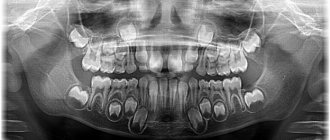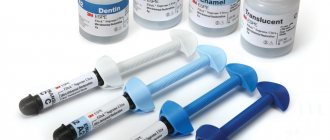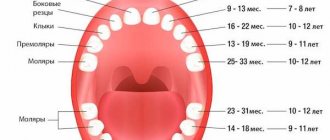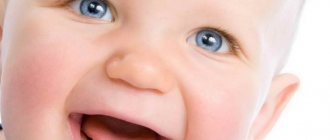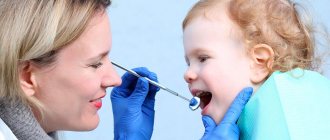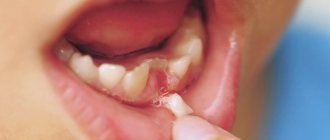The presence of milk teeth in adults cannot be attributed to the realm of fantasy or humor. This phenomenon can sometimes be encountered in dental practice. What contributes to the fact that a baby tooth can be preserved in adults and what to do with such a childhood “relic”?
Echo of childhood
Most people believe that baby teeth are closely associated with a touching and carefree childhood. It’s not for nothing that James Barry, a Scottish writer, in his fairy tale about Peter Pan - a boy who wants to always be young and not grow up - specifically describes that there were many milk pearl teeth in his mouth, and none of them had fallen out yet. Replacing baby teeth with permanent ones can be considered the same step into adulthood as the first room at school and the first two.
Teeth begin to change at about 5-6 years of age, and this process ends at about 12-14 years. Currently, according to the observations of many doctors, the replacement of baby teeth with permanent ones occurs in younger children than happened in past decades. But it also happens that baby teeth can be preserved in adults. Such cases can be encountered at 20, 30, and sometimes at 50 years of age. Why does this happen and what to do in such a situation?
Echo of childhood
Milk teeth are something from the realm of a carefree and touching childhood, most of us are sure. It is not for nothing that the Scottish writer James Barrie, in the fairy tale about Peter Pan - a boy who did not want to grow up and remained forever young - specifically mentions that “his mouth was full of pearly milk teeth. None have fallen out yet.” Replacing baby teeth with permanent ones is the same step into adulthood as first grade and first grade.
The change of teeth begins at the age of 5–6 and usually ends by the age of 14–16. Moreover, according to the observations of doctors, children are currently replacing their baby teeth with permanent ones at a younger age than several decades ago. But sometimes baby teeth persist into adulthood. People encounter similar cases at 20, 30, and even 50 years old! Why does this happen and what should be done in this case?
What to do with them
How to solve the problems that have arisen? This is decided by the dentist on a case-by-case basis.
- Often, a milk unit that has been well preserved is left, and it serves for a certain time. After all, a permanent unit may not grow in its place.
- An accurate diagnosis can be made after monitoring the x-ray. It shows whether there are undetected sprouts, and whether the root of the milk organ is resolving.
- If there is no permanent rudiment, and the roots of the temporary fixed unit do not change and the crown looks good, then tooth extraction is not prescribed.
- The same is done when the picture shows that the permanent unit will not erupt even after the elimination of the temporary tooth.
And one more thing: baby teeth are left if they do not interfere with other permanent units. But when baby teeth have not fallen out, but they are loose, create problems for the patient and do not look aesthetically pleasing, a decision may be made to remove them. The lost organ is replaced by prosthetics. A damaged unit that is not loose can be revived with lumineers or veneers, giving it the appearance of a permanent tooth
Why didn't my baby tooth fall out?
The structure of temporary and permanent teeth has certain differences. Dairy teeth have the same shape as molars, but they are smaller in size, their roots are much shorter, and they grow in the amount of only 20 pieces versus 32 permanent ones, including wisdom teeth. The service life of “children’s” teeth is also short: their roots begin to dissolve (dentists say “resorb”) approximately 2 to 3 years after they are fully formed. The process begins from the area where the crowns of the permanent teeth growing underneath touch them.
However, it happens that the rudiments of molars do not form for some reason. In this case, the roots of the milk teeth most often dissolve under the influence of the rudiments of adjacent permanent teeth. But sometimes this does not happen, and then “children’s” teeth are preserved in adults - doctors call them persistent, from the Latin persistere - to remain, to remain.
The reasons for the absence of permanent tooth buds can be different. Sometimes these are hereditary characteristics, metabolic disorders or disorders of the endocrine glands, trauma and osteomyelitis of the jaws. Chronic and acute inflammatory processes in baby teeth, in particular, periodontitis that is not cured in a timely manner, can also lead to damage and death of the rudiments of permanent teeth.
It also happens that the rudiments of permanent teeth, although they are formed, lie very deep, without touching the roots of milk teeth. This may be caused by insufficient space or misalignment of the permanent tooth. In these cases, milk teeth can remain in an adult.
Life cycle of teeth
Almost all the organs of our body are formed in the womb. Teeth are no exception. Already at the age of 6 weeks, the rudiments of the first teeth appear in the fetus: 10 pieces each. on the upper and lower jaw. Total - 20 small “buds”. This is the future milk bite.
See an interesting infographic about what kind of life our teeth live, and immediately after - in more detail about each stage and useful tips on how to preserve your teeth until old age.
Life cycle of teeth
| Birth | A child is born with fully formed tooth buds - they are located just under the surface of the gums. It is also interesting that some babies are already born with one or more teeth |
| 2-3 months | The baby begins to cut his first teeth. This is a rather unpleasant process, which is accompanied by excessive salivation, pain, deterioration of the child’s mood, and refusal to eat. In addition, during teething, local immunity is significantly reduced, which increases the risk of developing a viral infection. This explains the frequent increase in temperature during this period. |
| 6-14 months | Teeth begin to appear. The lower incisors grow first, then the upper ones. In total, the child should grow 20 pieces, including 2 multi-root chewing ones on each side - this will be the milk bite |
| 6-7 years | At this time, “baby” teeth begin to fall out. There is a change from a milk bite to a permanent one |
| 12-13 years old | The period of complete completion of the formation of a permanent dentition. By this age, the milky ones should fall out completely, and permanent ones should grow in their place. Helping teeth fall out in most situations is not required - this is a natural and physiological process that does not require third-party intervention. But it’s still worth seeing a doctor: it’s important to monitor both the wound and the process as a whole |
| 17-21 years old | During this period, “wisdom teeth” – the furthest ones in the row – may grow. There are 4 of them in total. There were no dairy predecessors in their place, so they have to pave the way on their own. In addition, they grow at a time when the bone tissue is fully formed and very hard. That is why their growth is associated with such problems as pain, acute inflammation of the mucous membrane, incorrect position in the row and even retention (the tooth does not erupt, forms and remains completely in the bone tissue) |
| 20 years and older | Starting at this age (and if there are problems with the body or when playing dangerous sports, even earlier), we begin to lose teeth. In the absence or poor hygiene, with poor nutrition, and the appearance of diseases of many organs and systems of the body, the enamel becomes weaker and is subject to attack by bacteria. With age, the amount of saliva decreases - and it is this that is a natural means of cleansing plaque. This is largely why teeth and gums become more susceptible to decay. It is also worth remembering that not only dental diseases, but also problems with gums lead to loss. |
What to do if an adult’s baby teeth don’t fall out?
Of course, baby teeth often cause problems in adults. Firstly, they are designed to have a short lifespan, and therefore their resistance to caries is much lower than that of permanent teeth. Secondly, baby teeth that do not fall out in time can interfere with the growth of permanent teeth and lead to their incorrect location. However, this does not mean that a baby tooth found in an adult must necessarily be removed. It all depends on each specific case. Most often, doctors recommend keeping well-preserved baby teeth in adults - let them last as long as they can. After all, the permanent ones may never emerge in their place.
In any case, the question of the fate of a baby tooth in an adult is decided only after an x-ray is taken. This will help to find out whether there are rudiments of an unerupted permanent tooth, as well as whether the roots of the baby tooth are being reabsorbed. If there are no rudiments and the roots of the baby tooth have not resolved, while the baby tooth is motionless and looks quite aesthetically pleasing, then it is not worth removing it. The same applies to cases when the permanent tooth, judging by the x-ray, is in such a position that it is impossible for it to erupt even after the removal of the milk tooth.
What to do?
Due to the fact that the lifespan of a baby tooth is much shorter than a molar one, its resistance to caries is much lower, so temporary teeth can cause many problems to their owner. In addition, milk teeth that are not eliminated in time interfere with the development of permanent teeth, stimulating incorrect positioning and the formation of an atypical bite.
However, it is not always necessary to remove a baby tooth when it is discovered. If the germ of a permanent tooth is not observed, that is, a new tooth will not grow, and the milk tooth is in good condition and does not cause discomfort or problems, then dentists recommend preserving it so that the tooth serves its purpose.
The best way to determine the fate of a baby tooth is with an X-ray or CT scan of the jaw. X-ray diagnostics will show whether there are rudiments of a permanent tooth and whether the process of root resorption has begun.
Is it possible to grow a baby tooth on an adult?
If the baby tooth is mobile or does not suit you from an aesthetic point of view, you still need to start with an x-ray examination. If the x-ray reveals that there are no permanent tooth buds, and the roots of the baby tooth have resolved, while the baby tooth has mobility of 3–4 degrees (that is, the tooth is very mobile), then it should be removed and further decide what type Prosthetics are more suitable for you to replace the loss.
If you are not satisfied with the appearance of the tooth, it is necessary, again using an x-ray, to determine the condition of the rudiments of the permanent tooth and the roots of the baby tooth. Further decisions will depend on each specific case, including the age of the patient and the place in the dentition of the baby tooth. If there are no rudiments and the roots of the baby tooth have not resolved, then you can install a veneer on it or carry out a tooth restoration, which will make it invisible in the dentition. And for those who want to completely transform their hair, we can recommend getting lumineers.
If there are rudiments of a permanent tooth, in this case it is worth assessing how much time they need before erupting and making a decision about removing the baby tooth and “pulling out” the permanent one.
Although milk teeth in adults are an anomaly, this is not a reason to necessarily part with them - they can serve you well for many years to come. However, it is possible that this “greetings from childhood” prevents the permanent tooth from growing. So, if you suddenly have a baby tooth, be sure to take an x-ray and consult a specialist.
How to keep your smile?
If there are no molar rudiments in the image and there are indications for removal, the specialists at Family Dentistry will offer to use the prosthetic service.
If the patient is not satisfied with the baby tooth, the doctor can cover it with a veneer or lumineer. It is also possible to perform tooth restoration.
If there are rudiments of a molar tooth, the dentist estimates how long it will take for eruption to occur. For the baby tooth, extraction is prescribed, and the permanent one is helped to erupt faster.
“Baby” teeth in adulthood are not normal. If the tooth is healthy and not causing problems, it can last for many more years. But, natural molars are much better in functionality and aesthetics than baby teeth or dentures restored by a dentist.
Indications for removal
It’s another matter if the causative element hurts. What to do in this case and how to treat it? In such a situation, specialists usually prescribe removal. Here are some more compelling reasons for such a radical solution:
- grade 3 or 4 mobility is noted,
- aesthetic defect in the absence of rudiments,
- there is not enough space for the correct arrangement of neighboring elements if the rudiment is missing or is too deep,
- the presence of a developed permanent tooth, which is prevented from erupting by a temporary unit,
- damage caused by caries, inflammatory processes or trauma.
Most often, such a tooth has to be removed.
Problems with aesthetics due to discrepancies in the size of the crowns are not a direct indication for removal. If there is no other reason for extraction, the appearance of the crown can be restored using light composites, veneers or lumineers. Many people are concerned about whether it is painful to remove persistent units. There is no need to worry about this - modern anesthetics are highly effective, so there will be no pain during the procedure.
Contraindications for removal - when the doctor refuses to admit
- diseases of the central nervous system;
- exacerbation of chronic diseases;
- heat;
- viral and infectious diseases – whooping cough, ARVI, influenza, mononucleosis;
- inflammatory processes in the oral cavity;
- neoplasm near the root.
Delete or leave
If there is a pronounced aesthetic defect, and there are also difficulties with the eruption of the permanent unit, removal is prescribed. But first, the dentist will conduct a thorough examination to make a final decision.
Assessing the state of a persistent unit
The tooth is left if it is well preserved and does not interfere with the rest, if the rudiment of a permanent element is missing or if it lies too deep, but the roots remain intact. To determine this, the patient undergoes X-ray diagnostics and, if necessary, computed tomography. The picture will show whether there are prerequisites for eruption, and will also help to assess the current state of the root system.
Identification of the rudiments of permanent units
If the rudiments are clearly visible in the picture, this is not yet a reason for removal. The decision is made based on the individual characteristics of the clinical picture. It largely depends on the age of the patient and the depth of occurrence. Sometimes removal followed by traction is prescribed, and in other cases everything is left as is. If there are no rudiments, the milk element is restored to give it an aesthetic appearance. For this purpose, veneers or lumineers can be installed, or prosthetics with a crown can be performed.
The photo shows the extraction of a permanent tooth.
How do permanent incisors and molars differ from primary incisors - structural features of persistent units
Temporary and permanent teeth are practically the same in shape, but still have some differences: crown size, root length, chemical composition, quantity in the mouth and service life. The milk elements are much smaller in size and correspond to the parameters of the child’s jaw system. The shortened length of the root is partly due to the rapid change of bite - this feature significantly facilitates the process of its resorption and loss of temporary units.
Only 20 milk teeth grow in the baby’s mouth, but how many permanent teeth erupt depends on the individual characteristics of the person - 28 or 32, together with the eights. Moreover, the latter appear at the age of about 25 years or may not erupt at all. In addition, temporary incisors and molars are covered with thinner and more fragile enamel, and the pulp chamber in them is wider and larger. Therefore, carious processes spread very quickly here. If treatment is not started in time, caries will very quickly lead to pulpitis - inflammation of the neurovascular bundle.
Treatment of adentia in adults
Adult patients are offered various types of removable and fixed dentures. Prosthetics on implants, installation of bridges on four implants and other prosthetic options at the patient’s choice are possible. Depending on the condition of his dental system, financial capabilities and wishes, dentists, as a rule, offer several treatment options to choose from.
When choosing a treatment method, it is important to understand the features of each design. The doctor, based on the condition of the patient’s oral cavity, offers him a choice of several prosthetic options.
Removable dentures
Partial or complete dentures should be replaced every 1.5 to 2 years. Therefore, even with complete loss of teeth, dentists offer an alternative type of prosthetics based on implants.
Clasp dentures
Dentures on a metal frame, on which an acrylic base is installed, and artificial teeth are installed on it. This solution makes it possible to significantly lighten the design of the prosthesis, making it thinner and more comfortable.
Bridges
In case of partial edentia, it is possible to install bridges. The non-removable structure is fixed on adjacent non-grindable teeth.
Implant-supported prosthetics
Implant-supported prosthetics are considered the most reliable and aesthetic way to restore dentition. The main advantages of this type of bone implantation include:
- long service life of the structure;
- aesthetic appearance;
- no need to grind adjacent teeth.
A denture installed on implants completely replaces missing teeth and performs a functional and aesthetic task.
Causes
The main and only cause of adentia is the absence or death of tooth buds. Primary pathology can be caused by heredity or provoked by various harmful factors acting during the formation of the fetal dental plate.
Complete congenital edentia is an extremely rare phenomenon. Formed due to ectodermal dysplasia. In this case, along with the absence of teeth, patients experience underdevelopment of hair, skin, nails, as well as sebaceous and sweat glands, eye lenses, and nerves.
Other common causes of pathology include the following:
- disturbance of mineral metabolism during the period of intrauterine development of the fetus against the background of diseases of the mother during pregnancy;
- illnesses in early childhood;
- heredity;
- disruption of the endocrine system;
- disruptions in the development of ectoderm - the outer germ layer of the embryo;
- treatment of concomitant diseases, including malignant neoplasms;
- chemotherapy, treatment with ionizing radiation;
- osteomyelitis and other purulent inflammations of the jaws.
The causes of secondary tooth loss in the process of life can be untreated caries, pulpitis, periodontitis, dental trauma, phlegmon, abscesses, illiterate provision of dental or orthopedic care, as well as other pathologies of the teeth and gums.
What to do if a baby tooth can cause problems
We answered the question of whether adults have primary incisors and molars, and also found out that often it is not necessary to get rid of them. However, in most cases, such an anomaly leads to displacement of the entire row, distortion of the bite, uneven distribution of the chewing load, due to which the crowns are subject to gradual destruction. Experts include other possible complications: aesthetic defects, the inability to chew food thoroughly, impaired diction and difficulties in hygiene care. All this contributes to the development of dental diseases. In such cases, both the front and outer teeth in adults are usually removed.
If there are no compelling indications for extraction, primary incisors and molars can serve you for many years. But the decision on further actions must be based on the results of the examination and x-ray diagnostics.
- Stepanov, G.V. Complex treatment for retention of individual teeth, 2000.

